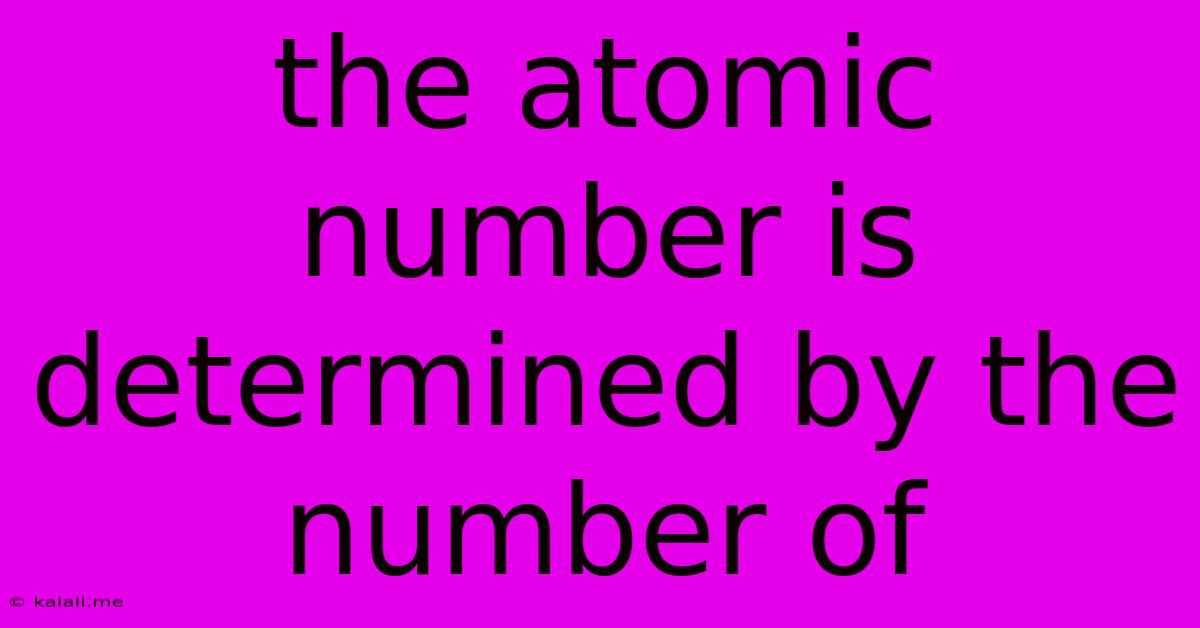The Atomic Number Is Determined By The Number Of
Kalali
Jun 16, 2025 · 3 min read

Table of Contents
The Atomic Number is Determined by the Number of Protons
The atomic number of an element is a fundamental property that defines its identity and distinguishes it from all other elements. It's a simple yet crucial concept in chemistry and physics. Understanding what determines the atomic number is key to understanding the periodic table and the behavior of matter. This article will explain that the atomic number is determined by the number of protons in an atom's nucleus.
Atoms, the basic building blocks of matter, are composed of three subatomic particles: protons, neutrons, and electrons. Protons and neutrons reside in the atom's central core, the nucleus, while electrons orbit around the nucleus. Each of these particles plays a unique role in determining an atom's properties. The atomic number, however, is solely determined by the number of protons present within the nucleus.
What are Protons?
Protons are positively charged subatomic particles with a mass approximately 1836 times greater than that of an electron. They are fundamental to the atom's structure and contribute significantly to its overall mass. Crucially, the number of protons defines the element itself.
The Significance of the Atomic Number
The atomic number is represented by the symbol 'Z'. For example, hydrogen (H) has an atomic number of 1 (Z=1), meaning it possesses one proton in its nucleus. Helium (He) has an atomic number of 2 (Z=2), indicating two protons. Each element has a unique atomic number; no two elements share the same number of protons. This unique proton count is what makes each element distinct in its chemical and physical properties.
How Atomic Number Relates to Other Atomic Properties
The atomic number is directly related to other properties of an atom:
- Number of Electrons: In a neutral atom, the number of electrons is equal to the number of protons. This ensures the overall charge of the atom is zero. Ions, on the other hand, have gained or lost electrons, resulting in a net positive or negative charge.
- Chemical Properties: The number of protons, and consequently the arrangement of electrons, largely determines an element's chemical behavior. Elements in the same column of the periodic table have similar chemical properties because they have the same number of valence electrons, which are the electrons in the outermost shell. This influences how atoms interact and form chemical bonds.
- Isotopes: Isotopes are atoms of the same element that have the same number of protons but a different number of neutrons. This means isotopes have the same atomic number but different mass numbers (the sum of protons and neutrons). While the number of neutrons affects the mass of the atom, it does not change its chemical properties significantly.
Understanding the Periodic Table
The periodic table organizes elements based on their atomic numbers, reflecting their properties and relationships. Elements are arranged in increasing order of atomic number, revealing patterns and trends in their chemical and physical behavior. The periodic table’s structure, with its rows and columns, directly relates to electron shell configuration and the recurring patterns of chemical properties.
In conclusion, the atomic number is a fundamental characteristic that unequivocally identifies an element. It is unequivocally determined by the number of protons in the atom's nucleus, a property that directly influences the atom's mass, chemical properties, and its position within the periodic table. Understanding this concept provides a solid foundation for comprehending the structure and behavior of matter.
Latest Posts
Latest Posts
-
Least Common Multiple Of 40 And 50
Jun 16, 2025
-
Nitrogen Used By Plants Is In The Form Of
Jun 16, 2025
-
Can You Take The Act As An Adult
Jun 16, 2025
-
What Is Unit Weight Of Water
Jun 16, 2025
-
Difference Between A Crime And A Tort
Jun 16, 2025
Related Post
Thank you for visiting our website which covers about The Atomic Number Is Determined By The Number Of . We hope the information provided has been useful to you. Feel free to contact us if you have any questions or need further assistance. See you next time and don't miss to bookmark.